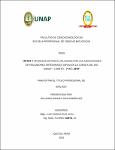| dc.contributor.advisor | García Ruiz, Luis | |
| dc.contributor.advisor | Flores Nunta, Saul | |
| dc.contributor.author | Riva Rodríguez, Rolando Manuel | |
| dc.date.accessioned | 2023-03-03T18:37:24Z | |
| dc.date.available | 2023-03-03T18:37:24Z | |
| dc.date.issued | 2022 | |
| dc.identifier.uri | https://hdl.handle.net/20.500.12737/8882 | |
| dc.description.abstract | The present investigation was carried out between the months of January to April 2019, with the objective of determining the fishing gear and gear used by the artisanal fishermen associations (APAs) of the Nanay river basin; For this, the quantitative method and the non-experimental design were used, the size of the study sample was made up of 132 fishermen who met the inclusion criteria; the techniques used were the application of surveys and visits to those involved; the evaluation instrument used was the questionnaire on the socio-economic characterization survey form of the fisherman. The results obtained with respect to the fishing gear and gear used by the artisanal fishermen associations of the communities under study show that the respondents refer to the use of fishing materials called "mesh or trap", "rod" and "line". during their working day, since the aforementioned fishing gear guarantees a greater catch of fish in volume; the use of certain gear and gear in many cases depends on the rising or emptying of the river, likewise it refers to the variety of fish caught with fishing gear both in the growing and emptying seasons, made up of species such as boquichico (Prochilodus nigricans), paco (Piaractus brachypomus)corvina, gamitana (Colossoma macropomun), corvine (Plagioscion squamossimus), palometa , maiden (Pseudoplatystoma fasciatum), maparate (Hypophthalmus marginatus), etc. The species that were least found during capture time are chio-chio (Psectrogaster rutiloides), yaraqui (Semaprochilodus insignis), others; the hierarchical preference of the use of fishing gear and gear used during the river's flooding are the, bowling, jamu, jica and redecilla, while in the dry season they usually use bowling and jamu, (100% utility) followed of jica and net (97% utility). It is concluded that the fishing gear and gear used by the fishermen of the artisanal fishermen's associations in the Nanay river basin have an influence on the capture of both food fish and ornamental fish. | en_US |
| dc.description.abstract | La presente investigación se desarrolló entre los meses de enero a abril del 2019, teniendo como objetivo determinar las artes y aparejos de pesca utilizados por las asociaciones pescadores artesanales (APAs) de la cuenca de río Nanay; para ello se empleó el método cuantitativo y el diseño no experimental, el tamaño de la muestra de estudio estuvo conformado por 132 pescadores que reunían los criterios de inclusión; las técnicas utilizadas fueron la aplicación de encuestas y visitas a los involucrados; el instrumento de evaluación utilizado fue el cuestionario sobre la ficha de encuesta de caracterización socio-económica del pescador. Los resultados obtenidos con respecto a las artes y aparejos de pesca utilizados por las asociaciones pescadores artesanales de las comunidades en estudio se aprecia que los encuestados refieren el uso de materiales de pesca denominado “malla o trampa”, “varandilla” y el “espinel” durante su jornada laboral, ya que los mencionados aparejos de pesca garantizan una mayor captura de peces en volumen; el uso de cierto artes y aparejos en muchos casos depende de la creciente o vaciante del rio, así mismo se refiere que la variedad de peces capturados con aparejos de pesca tanto en temporada de creciente como de vaciante, la conforman las especies como boquichico (Prochilodus nigricans), paco (Piaractus brachypomus), gamitana (Colossoma macropomun), corvina (Plagioscion squamossimus), palometa (Mylossoma albiscospus), doncella (Pseudoplatystoma fasciatum), maparate (Hypophthalmus marginatus), etc. Las especies que menos se encontró durante en tiempo de captura son chio-chio (Psectrogaster rutiloides), yaraqui (Semaprochilodus insignis), otros; la preferencia jerárquica de los artes y aparejos de pesca utilizados durante la creciente del río son, bolichera, jamu, jica y redecilla, mientras en el periodo de vaciantes suelen usar bolichera y jamu, (100% de utilidad) seguidas de jica y redecilla (97% de utilidad). Se concluye que las artes y aparejos de pesca empleados por los pescadores de las asociaciones de pescadores artesanales en la cuenca de río Nanay tienen una influencia en la captura tanto de peces de consumos como de peces ornamentales. | es_PE |
| dc.format | application/pdf | es_PE |
| dc.language.iso | spa | es_PE |
| dc.publisher | Universidad Nacional de la Amazonía Peruana | es_PE |
| dc.rights | info:eu-repo/semantics/openAccess | * |
| dc.rights.uri | https://creativecommons.org/licenses/by/4.0/ | * |
| dc.subject | Pesca artesanal | es_PE |
| dc.subject | Aparejo (náutica) | es_PE |
| dc.subject | Artes de pesca | es_PE |
| dc.subject | Pescadores | es_PE |
| dc.title | Artes y aparejos de pesca utilizados por las asociacioes de pescadores artesanales (APAs) en la cuenca del río Nanay - Loreto - Perú, 2019 | es_PE |
| dc.type | info:eu-repo/semantics/bachelorThesis | es_PE |
| thesis.degree.discipline | Ciencias Biológicas | es_PE |
| thesis.degree.grantor | Universidad Nacional de la Amazonía Peruana. Facultad de Ciencias Biológicas | es_PE |
| thesis.degree.name | Biólogo(a) | es_PE |
| dc.subject.ocde | https://purl.org/pe-repo/ocde/ford#4.01.03 | es_PE |
| renati.author.dni | 72552169 | |
| renati.advisor.orcid | https://orcid.org/0000-0003-2691-8138 | |
| renati.advisor.orcid | https://orcid.org/0000-0002-4267-0462 | |
| renati.advisor.dni | 05337175 | |
| renati.advisor.dni | 09671010 | |
| renati.type | https://purl.org/pe-repo/renati/type#tesis | es_PE |
| renati.discipline | 511206 | es_PE |
| renati.level | https://purl.org/pe-repo/renati/level#tituloProfesional | es_PE |
| renati.juror | Campos Baca, Luis Exequiel | |
| renati.juror | Del Aguila Chavez, Javier | |
| renati.juror | Sánchez Riveiro, Homero | |
| dc.publisher.country | PE | es_PE |





